Despite Western Australia’s long coastline, our aquaculture industry is small by global standards – but it is growing and diversifying, with exciting opportunities on the horizon.
Aside from contributing to food security, aquaculture creates employment and business opportunities in areas such as feed and equipment manufacturing. It also has direct and indirect economic benefits to the state, particularly in regional areas.
In 2017-18, the total value of WA’s commercial fisheries and aquaculture production was $633 million. Of this, pearling (which is mostly commercially farmed) contributed $52 million (8%) and aquaculture $27 million (4%).
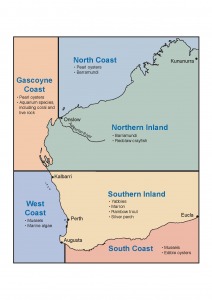
Location of main aquaculture species farmed in Western Australia.
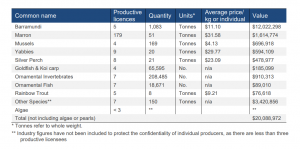
Production for the Western Australian aquaculture industry in 2016/17
Current production – main aquaculture species in WA
Barramundi Lates cacarifer
Popular native table fish with high market demand which is sold as whole fish, live fish and fillets.
WA’s barramundi production is largely located in the Kimberley region, at Cone Bay.
Barramundi can be farmed in indoor recirculating systems, land-based ponds and sea cages. For more detailed information about barramundi aquaculture in Australia, see: https://www.agrifutures.com.au/farm-diversity/barramundi-aquaculture/
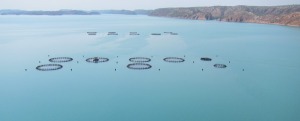
Barramundi farm in Cone Bay
Rainbow trout Oncorhynchus mykiss
Good eating fish that is popular with freshwater anglers.
Trout was introduced to Australia for recreational fishing and aquaculture. It is difficult for the species to spawn naturally in WA’s conditions, so they are artificially bred in earthen and concrete ponds at the Pemberton Freshwater Research Centre. Approximately 80% of this stock is released into selected public south-west waterways for recreational fishing. The rest is sold to licensed aquaculture producers and private farm dams for recreational fishing and tourism, or kept for future brood stock and research. For more information about trout aquaculture, see: Inland_Aquaculture_FOP_111
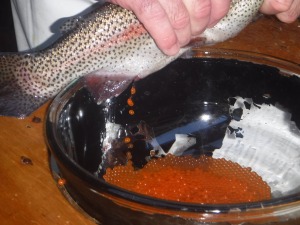
Eggs being stripped as part of trout aquaculture at the Pemberton Freshwater Research Centre.
Silver perch Bidyanus bidyanus
Sold as a live or processed product for human consumption and for aquariums and aquaponics purposes.
Silver Perch has been introduced to WA from the Murray-Darling river system and can only be cultured in impounded waters where the risk of translocation to local waterways is minimal.
Species is mostly grown as part of integrated farming systems in tanks and approved farm dams.
For more information about silver perch aquaculture, see: Inland_Aquaculture_FOP_111
Aquarium fish
Attractive, colourful fish such as koi, goldfish, various carps and cichlids, bred for aquariums and
aquaponics.
Fish include both native and exotic species, however culture of non-native species requires translocation approvals and is subject to strict conditions.
Usually grown in tanks and purpose built ponds by small family based operators specialising in niche, often high-value products.
For more information about aquarium fish aquaculture, see: the-australian-ornamental-fish-industry Inland_Aquaculture_FOP_111
Ornamental invertebrates
Corals, live rock and associated products (eg. live sand) are grown and sold for display and to maintain healthy water quality of marine aquariums.
Different species can be grown in onshore, recirculated or flow through systems and in offshore open water systems.
Offshore open water systems require little maintenance and no additional feeding (just sunlight). For more information about aquarium fish aquaculture, see: Aquaculture_of_Coral_FMP_245
Marron Hairy marron Cherax tenuimanus, Smooth marron Cherax cainii
High value product that is usually sold live.
Marron is native to southwest WA.
Its culture is almost entirely based on semi-intensive systems using purpose-built earthen ponds.
Harvesting is cyclical, expanding during times of high rain fall when dams and waterways flood, and contracting during drought and when river flows slow down. For more information about freshwater crayfish aquaculture, see: http://www.agrifutures.com.au/farm-diversity/freshwater-crayfish-redclaw/ Inland_Aquaculture_FOP_111
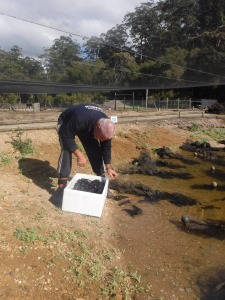
Wild caught breeding marron introduced into a pond as part of a program to improve genetic characteristics of stock. Mesh bags in the water provide shelter and protection for the animals.
Yabby Cherax albidus
Introduced species to WA, usually sold live.
Yabbies thrive in muddy waters and are usually grown in existing farm dams and water ways as part of farm diversification.
Growing yabbies is restricted to the inland agricultural areas of eastern Wheatbelt and Great Southern regions, away from marron production zones. For more information about yabby aquaculture, see: http://www.fish.wa.gov.au/Fishing-and-Aquaculture/Aquaculture/Pages/default.aspx fmp160 Inland_Aquaculture_FOP_111
Redclaw crayfish Cherax quadricarinatus
Tropical freshwater crayfish species grown in WA’s north, usually sold live.
Almost entirely based on semi-intensive aquaculture using purpose-built ponds, with water temperature over 23oC and shelter such as mesh materials and shade cloth.
Can be sold at about 12 months giving it comparative advantage over other freshwater crayfish like marron, which might take up to five years to get to market.
Can survive for reasonable periods out of water if kept cool and moist so relatively easy to be delivered to consumers live, giving them a strong market advantage. For more information about freshwater crayfish aquaculture, see: Inland_Aquaculture_FOP_111 http://www.agrifutures.com.au/farm-diversity/freshwater-crayfish-redclaw/
Mussels Mytilus galloprovincialis
Main edible mollusc cultured in WA.
Blue mussels are grown near Albany and Cockburn Sound on floating long line and dropline systems.
Up until recently, the industry relied on wild spat settlement and due to its variability was showing a downward trend. However, stock is now raised at the Shellfish Hatchery in Albany. For more information about mussel aquaculture, see: FRDC_Report_Blue_Mussel_Hatchery
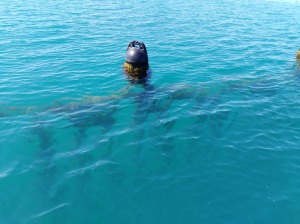
Floatation buoy holding up long lines at Cockburn Sound. Ropes on
which mussels grow are visible just below the surface.
Pearl oyster Pinctada maxima, Pinctada margitifera, Pinctada fucata
Grown for pearls, pearl shell and – on a small scale – for pearl meat.
Oysters are grown in hatcheries or collected from the wild. They are ‘seeded’ to stimulate pearl growth by surgically inserting a bead into the oyster’s gonad and then transferred to a farm where they are grown on line systems. For more information about pearl oyster aquaculture, see: http://www.fish.wa.gov.au/Fishing-and-Aquaculture/Pearling/Pages/default.aspx http://www.mesa.edu.au/aquaculture/aquaculture38.asp
Edible oyster Saccostrea glomerata, Saccostrea cucullata, Ostrea angasi, Saccostrea echinata
Important area of aquaculture growth in WA.
Oysters are grown in hatcheries and transferred to farms. Grown on line systems, with emerging technologies, such as ‘flip’ farming systems. Both tropical and cold water shellfish are grown. For more information about edible oyster aquaculture, see: https://www.sciencedirect.com/science/article/pii/S0308597X19305433 Edible-Oysters-Aquaculture-in-the-Pilbara-and-Gascoyne-2016 https://www.aquaculturecouncilwa.com/get-into-aquaculture/the-albany-shellfish-hatchery/
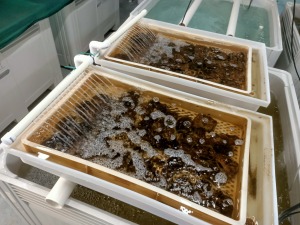
Brood stock for the native Black lipped rock oyster (Sacostrea glomerata) culture,
trialed at the Hillarys Fisheries and Marine Research Laboratory.
Algae Dunaliella salina
Microalgae grown for beta-carotene production, and for shellfish and prawn aquaculture feed.
Reared in large shallow lagoons and ponds north of Geraldton. For more information about algae aquaculture, see: http://www.fao.org/3/AB728E/AB728E06.htm

Algae rich pink waters of the Hutt Lagoon north of Geraldton.
Potential for future growth
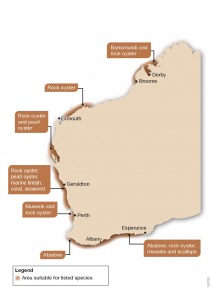
Prospective areas and species for further aquaculture growth in WA
The most significant future aquaculture growth in Western Australia is anticipated in the following areas:
- finfish, including yellowtail kingfish and barramundi;
- abalone;
- edible oysters;
- fresh water species, driven by significant industry investment and potential for growth in fishing
tourism in the South West and the Kimberley; - coral and seaweed.
As part of its commitment to developing a sustainable marine aquaculture industry, the State Government is setting up aquaculture development zones. Three zones are being established: in the Kimberley, in the State’s mid-west and in the Great Southern near Albany.
Aquaculture zones provide ‘investment ready’ platforms with strategic environmental approvals and management policies already in place. This allows commercial aquaculture operations to be set up without the need for lengthy, complex and expensive approval processes. The aim is to make it faster, less costly and more efficient to set up aquaculture businesses in Western Australia.
Barriers for aquaculture in Western Australia
To ensure future growth in aquaculture in the state, the following challenges need to be overcome by
current and/or future producers:
- few sheltered and suitable coastal marine sites (WA coastal waters are generally exposed and there are few large areas that are sheltered);
- competition for other water and land uses;
- lack of infrastructure and services in some regional areas, leading to high production costs particularly in relation to transportation, inputs such as feeds and power and retention of suitably qualified staff;
- distance to markets;
- complex rules and regulations;
- limited opportunities for training, compared to other states;
- potential biosecurity risks.
Role of government
Both the State and Federal government have important functions in relation to aquaculture development
in WA. Some of these functions are:
- administration of and investment into programs for research;
- management of biosecurity and aquatic health;
- regulation of market access and trade;
- monitoring and regulation of aquaculture production, including in respect to environment and food
safety standards;
References
Department of Primary Industry and Resource Development, Aquaculture development plan – draft, aquaculture_development_plan_draft
Department of Primary Industry and Resource Development, Aquaculture position paper, aquaculture_position_paper
